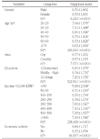Abstract
Objectives
Health is closely related to an individual's assessment of their quality of life and their subjective level of happiness. The aim of this study was to investigate the association between happiness index and self-rated health by utilizing a community health survey in Korea.
Methods
The study participants were 17,937 people living in Gyeongsangnam-do, Korea, who completed a community health survey in 2014. The non-subjective variables included in the statistical analysis were sex, age, region, education, income, and economic activity. The subjective awareness variables included self-rated health, self-rated oral health, chewing difficulty, pronunciation difficulty, and happiness index. Statistical analysis of the data was done using the SPSS 21.0 program.
Results
Evaluation of the subjective awareness levels revealed that the respondents that were better educated, whose income levels were higher, and those who engaged in an economic activity found themselves to be in better physical health and oral health. In contrast, the respondents that were female, older, and with residence in the counties reported a higher incidence of chewing difficulty. There was a positive correlation between happiness index and subjective awareness level, and a negative correlation between chewing difficulty and pronunciation difficulty. Happiness index was influenced the most by subjective health levels, followed by income, age, pronunciation difficulty, subjective oral health, chewing difficulty, academic credential, region, and sex.
Conclusions
Therefore, in order to improve the happiness index of community residents, regular health checkups and systematic oral health education should be prepared in order to improve awareness of subjective health and reduce discomfort in the oral cavity, and efforts should be made to reduce the gap between regions.
Figures and Tables
Table 2
Self rated oral health, self rated health according to the general characteristics (Mean±SD)

Table 3
Current chewing difficulty, pronunciation difficulty according to the general characteristics (Mean±SD)

References
1. Kang JG. The Connection with the Perceived Life Quality of Participants in Leisure Sports by Social Demographic Character. J Sport Leis Stud. 2003; 19:867–880.

2. Kim YR. The Effects of Sport-for-all Participation on Happy life. Korean J Sociol Sport. 2008; 21:151–172.

3. Kim MK. The analysis of the self-rated health status among social stratum groups in Korea[master's thesis]. Seoul: Yonsei University;2008. [Korean].
4. Kim HR. A study of the relationship between socioeconomic factors, health behaviors and chronic diseases[doctoral thesis]. Seoul: Hanyang University;2002. [Korean].
5. Kim MA, Kim JS, Woo HS, Lee SJ, Lee SY, Lee HO, et al. Public Health. 2th ed. Seoul: Komoonsa;2016. p. 3–22.
6. Dijkers M. Quality of Life after spinalcord injury:a meta analysis of the effects of disablement component. Spinal cord. 1997; 35:829–840.

7. Borzecki AM, Lee A, Kalman D, Kazis LE. Do poor health behaviors affect health-related quality of life and healthcare utilization among veterans? The Veterans Health Study. J Ambul Care Manage. 2005; 28:141–156.

9. Linn BS, Linn MW. Objective and self-assessed health in the old and very old. Soc Sci Med Med Psychol Med Sociol. 1980; 14A:311–315.

10. Cockerham WC, Sharp K, Wilcox JA. Aging and perceived health status. J Gerontol. 1983; 38:349–355.

11. Hunt SM, McEwen J, McKenna SP. Perceived health: Aged and sex comparisons in a community. J Epidemiol Community Health. 1984; 34:156–160.
12. Idler EL, Benyamini Y. Self-rated health and mortality: A review of twenty-seven community studies. J Health Soc Behav. 1997; 38:21–37.

13. Jung MH, Kim SS, Kim YS, Ahn ES. Relationship of socioeconomic status to self-rated oral health. J Dent Hyg Sci. 2014; 14:207–213.
14. Hildebrand V, Kerm PV. Income inequality and self-rated health status: evidence from the European community household panel. Demography. 2009; 46:805–825.

15. Luchi CA, Peres KG, Bastos JL, Peres MA. Inequalities in self rated oral health in adults. Rev Saude Publica. 2013; 47:740–751.
16. Song KH. A study on the evaluation of health and oral healthrealated quality of life in Korean adults[doctoral thesis]. Seoul: Hanyang University;2007. [Korean].
17. Lee GR. The impact of DMFT index on oral health related quality of life in community-dwelling elderly. J Korean Acad Oral Health. 2008; 38:396–404.
18. EuroQol Group. EuroQol A new facility for the measurement of health-related quality of life. Health Policy. 1990; 16:199–208.
19. Sach TH, Barton GR, Doherty M, Muir KR, Jenkinson C, Avery AJ. The relationship between body mass index and health-related quality of life: comparing the EQ-5D, EuroQol VAS and SF-6D Philadelphia. Int J Obes (Lond). 2007; 31:189–196.

20. Kang EJ, Shin HS, Park HJ, Jo MW, Kim NY. A valuation of health status using EQ-5D. Korean J Health Econ Policy. 2006; 12:19–43.
21. Marinic M, Brkljacic T. Love over gold-The correlation of happiness level with some life satisfaction factors between persons with and without physical disability. J Dev Phys Disabil. 2008; 20:527–540.

22. Smith DM, Langa KM, Kabeto MU, Ubel PA. Health, wealth, and happiness: Financial resources buffer subjective well-being after the onset of a disability. Psychol Sci. 2005; 16:663–666.

23. Cho YS. A study on public for “Developing a country with better life”. J Korean Public Policy. 2012; 14:3–30.
24. Yoon HS. Oral health status and congitive happiness of the elderly[doctor's degree]. Busan: Inje University;2011. [Korean].
25. Kim JH, Hong MH, Jeong MA. Subjective oral health awareness level and quality of life study. Korean Soc Ind Appl. 2010; 1:57–67.
26. Jung MH, Kim SS, Kim YS, Ahm ES. Relationship of socioeconomic status to self-rated oral health. J Dent Hyg Sci. 2014; 14:207–213.
27. Lee JM, Kin WJ, Sohn HS, Chun JH, Lee MJ, Park HS. Influences on health behaviors execution and self rated health as socioeconomic class by the age bracket. J Korea Contents Assoc. 2012; 12:317–327.

28. Kim TH, Jin HJ. Current chewing difficulty according to dental prosthesis needs in Korean elderly. J Korea Acad Ind Coop Soc. 2014; 15:4353–4360.

29. Hong IO. Health related quality of life by smoking, drinking, exercise, obesity and sociodemographic variables using EQ-5D[master's thesis]. Seoul: Sahmyook University;2011. [Korean].
30. Kim YH. Factors related to health-related quality of life among adult smokers in smoking cessation clinics. J Korean Data Anal Soc. 2013; 15:263–275.




 PDF
PDF ePub
ePub Citation
Citation Print
Print






 XML Download
XML Download